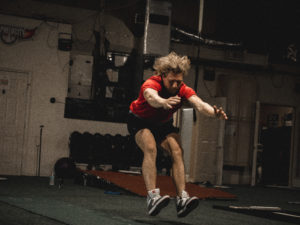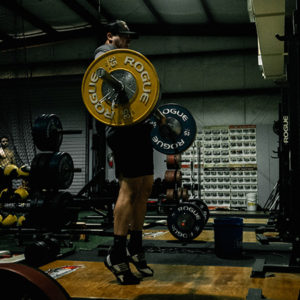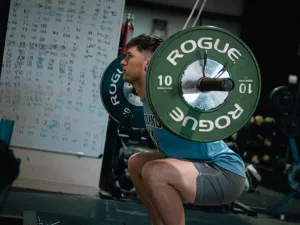In this article, we will be examining the relationship between lower body power and pitching velocity in professional baseball pitchers, with a focus on the findings from the case study conducted by Donahue, P. T., Beiser, E., Wilson, S. J., Hill, C. M., & Garner, J. C. (2018). The relationship between measures of lower body power and pitching velocity in professional baseball pitchers. Journal of Trainology, 7, 24-27. The study aimed to explore the association between lower body power output, assessed through countermovement vertical jump (CMVJ) and sprint cycling performance, and pitching velocity in elite professional baseball pitchers. Understanding the implications of these findings can help coaches and athletes develop targeted training programs that improve pitching performance and inform best practices in the sport.
Lower body power in baseball players, especially pitchers, has long been a source of debate among athletes and coaches. Increased throwing velocity has numerous benefits on the field, as it reduces the hitter's reaction time and makes making contact with the ball more difficult. According to research, the lower body is important in generating power and energy, which affects pitching velocity. Various training techniques, such as plyometrics, Olympic lifting variations, and conventional resistance training, have been used to improve and maintain throwing velocities by increasing baseball pitchers' power-generating capacity.
Despite its importance, the exact relationship between lower body power output and throwing velocity is still unknown. Previous research has looked at the relationship between lower body strength and throwing velocity in sports like cricket and handball, as well as in adolescent baseball players. The current study, on the other hand, is concerned with the connection between countermovement vertical jump (CMVJ) and sprint cycling (Cycle) performance and pitching velocity in top professional baseball pitchers. This research seeks to provide valuable insights into the role of lower body power in improving pitching performance by examining these relationships.
Assessing Lower Body Power Output: CMVJ and Sprint Cycling Performance
 The research used two techniques to assess lower body power in order to evaluate the relationship between lower body power output and pitching velocity: countermovement vertical jump (CMVJ) and sprint cycling performance. (Cycle). The CMVJ test assesses an athlete's ability to produce force quickly and explosively, making it a useful evaluation of the lower body's contribution to pitching performance. Athletes execute a rapid downward movement followed by an upward jump during the CMVJ, which gives data on the athlete's peak and mean power output, as well as peak and mean velocity.
The research used two techniques to assess lower body power in order to evaluate the relationship between lower body power output and pitching velocity: countermovement vertical jump (CMVJ) and sprint cycling performance. (Cycle). The CMVJ test assesses an athlete's ability to produce force quickly and explosively, making it a useful evaluation of the lower body's contribution to pitching performance. Athletes execute a rapid downward movement followed by an upward jump during the CMVJ, which gives data on the athlete's peak and mean power output, as well as peak and mean velocity.
A sprint cycling test of 30 seconds is used to evaluate sprint cycling performance. This test is intended to assess an athlete's anaerobic capacity, which is important for sustaining maximum effort during short-duration, high-intensity activities like pitching. The sprint cycling exam measures peak and mean power production, as well as the relationship between these variables and pitching velocity.
CMVJ and sprint cycling performance tests are both useful for determining the function of lower body power in baseball pitching. While the CMVJ test emphasizes the explosive aspect of lower body power, the sprint cycling test reveals an athlete's ability to sustain power output over a short period of time. Researchers can establish the importance of lower body power in improving pitching performance by comparing the findings of these tests to pitching velocity.
Understanding the relationship between lower body power output and pitching velocity is critical for creating successful baseball pitcher training programs. Coaches and athletes can tailor their training regimens to optimize pitching velocity and general performance on the field by incorporating exercises that target the particular aspects of lower body power found through CMVJ and sprint cycling performance tests. This information can also be used to identify potential areas for development and track progress over time, assisting athletes in reaching their full potential as professional baseball pitchers.
The Relationship between Lower Body Power and Pitching Velocity in Professional Baseball Pitchers

Olympic Lifting to build Explosive power for Pitchers and position players in baseball.
The kinetic chain involved in the pitching motion begins from the ground up, with force produced through the lower extremities transferring progressively through the core and upper body, eventually resulting in the baseball being released at maximum velocity. Understanding the connection between lower body power and pitching velocity can provide useful insights for improving a pitcher's performance. Although earlier research has indicated a positive relationship between lower body power and throwing velocity in various overhand throwing sports, the current study sought to investigate this relationship in professional baseball pitchers specifically.
The study's findings revealed a statistically significant positive association between mean power during the sprint cycling test and both peak and mean throwing velocities (r = 0.441 and 0.428, respectively). The countermovement vertical jump (CMVJ) test, on the other hand, did not demonstrate a significant relationship with pitching velocity. These results imply that an athlete's anaerobic capacity, as measured by mean power output during sprint cycling, is more closely related to pitching velocity than explosive power, as measured by the CMVJ test.
This understanding is essential for developing training programs that focus on the particular aspects of lower body power that are most important for pitching performance. Coaches and athletes can possibly improve pitching velocity and overall on-field performance by concentrating on exercises that improve anaerobic capacity, such as sprint cycling. It should be noted that the findings of this study may be more applicable to professional pitchers, and more research is required to determine the generalizability of these results to pitchers of varying skill levels.
In conclusion, the relationship between lower body power and pitching velocity in professional baseball pitchers is complex, with different degrees of significance based on the power assessment methods used. The research emphasizes the significance of anaerobic capacity, as measured by sprint cycling performance, in influencing pitching velocity. Understanding these relationships allows coaches and athletes to create more targeted training regimens, resulting to better pitching performance and field success.
Implications for Training and Performance Enhancement in Baseball Pitching
 The results of this research on the relationship between lower body power and pitching velocity have several implications for the design and implementation of baseball pitching training programs. Because the findings show a substantial relationship between mean power during sprint cycling and both peak and mean throwing velocities, coaches and athletes should consider incorporating training methods that explicitly target anaerobic capacity development into their programs.
The results of this research on the relationship between lower body power and pitching velocity have several implications for the design and implementation of baseball pitching training programs. Because the findings show a substantial relationship between mean power during sprint cycling and both peak and mean throwing velocities, coaches and athletes should consider incorporating training methods that explicitly target anaerobic capacity development into their programs.
High-intensity interval training, which involves short bursts of maximal effort followed by brief recovery periods, and resistance training exercises that stress power and speed, such as Olympic lifts and plyometrics, are examples of exercises that can improve anaerobic capacity. Incorporating these kinds of exercises into a pitcher's training routine has the potential to improve lower body power output and, as a result, pitching velocity. However, it is critical to ensure that the training program is tailored to the needs and abilities of the individual athlete, taking into account variables such as current fitness level, injury history, and specific performance goals.
Another essential consideration is the tracking and evaluation of an athlete's progress over time. Regular evaluation of lower body power output and pitching velocity can provide valuable feedback on the efficacy of the training program and help identify areas for improvement. Modifying training intensity, volume, or exercise selection may be necessary to optimize the development of the particular power attributes that add most to pitching performance. Tracking an athlete's progress can also help keep motivation and provide tangible evidence of growth, which can contribute to overall performance improvement.
In conclusion, the implications of this study's results on the relationship between lower body power and pitching velocity can help inform the creation of targeted baseball pitcher training programs. Coaches and athletes can possibly improve pitching performance on the field by stressing exercises that improve anaerobic capacity, such as sprint cycling and other high-intensity workouts. Regular progress monitoring and evaluation will ensure that the training program stays effective and supports the athlete's performance goals.
Unleashing Your Pitching Potential: Join the 3X Velocity Camp Today
 Don't pass up this chance to improve your pitching abilities and achieve your full potential. Join us at the 3X Velocity Camp, where you can apply the principles found in Donahue et al. (2018)'s groundbreaking research to your velocity training. Our experienced coaches will guide you through targeted training programs intended to increase your lower body power output and pitching velocity at the 3X Velocity Camp.
Don't pass up this chance to improve your pitching abilities and achieve your full potential. Join us at the 3X Velocity Camp, where you can apply the principles found in Donahue et al. (2018)'s groundbreaking research to your velocity training. Our experienced coaches will guide you through targeted training programs intended to increase your lower body power output and pitching velocity at the 3X Velocity Camp.
Act now to reserve your place at the 3X Velocity Camp! You'll have the opportunity to work with industry experts, network with other baseball pitchers, and learn cutting-edge methods to improve your performance on the mound. Don't let this chance pass you by—the 3X Velocity Camp is where your journey to becoming a faster, more powerful pitcher starts. Register now to realize your full potential as a competitive baseball pitcher.


